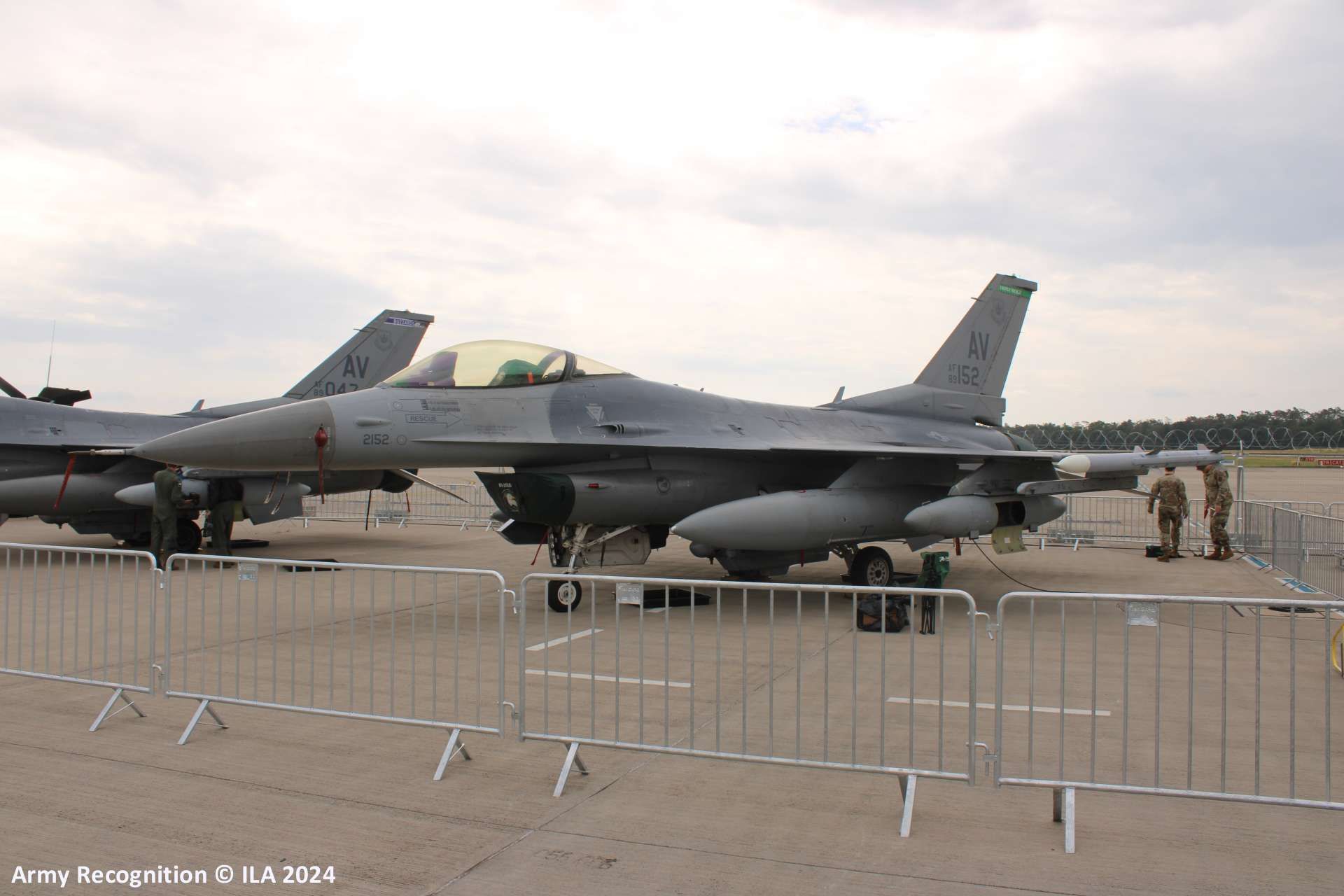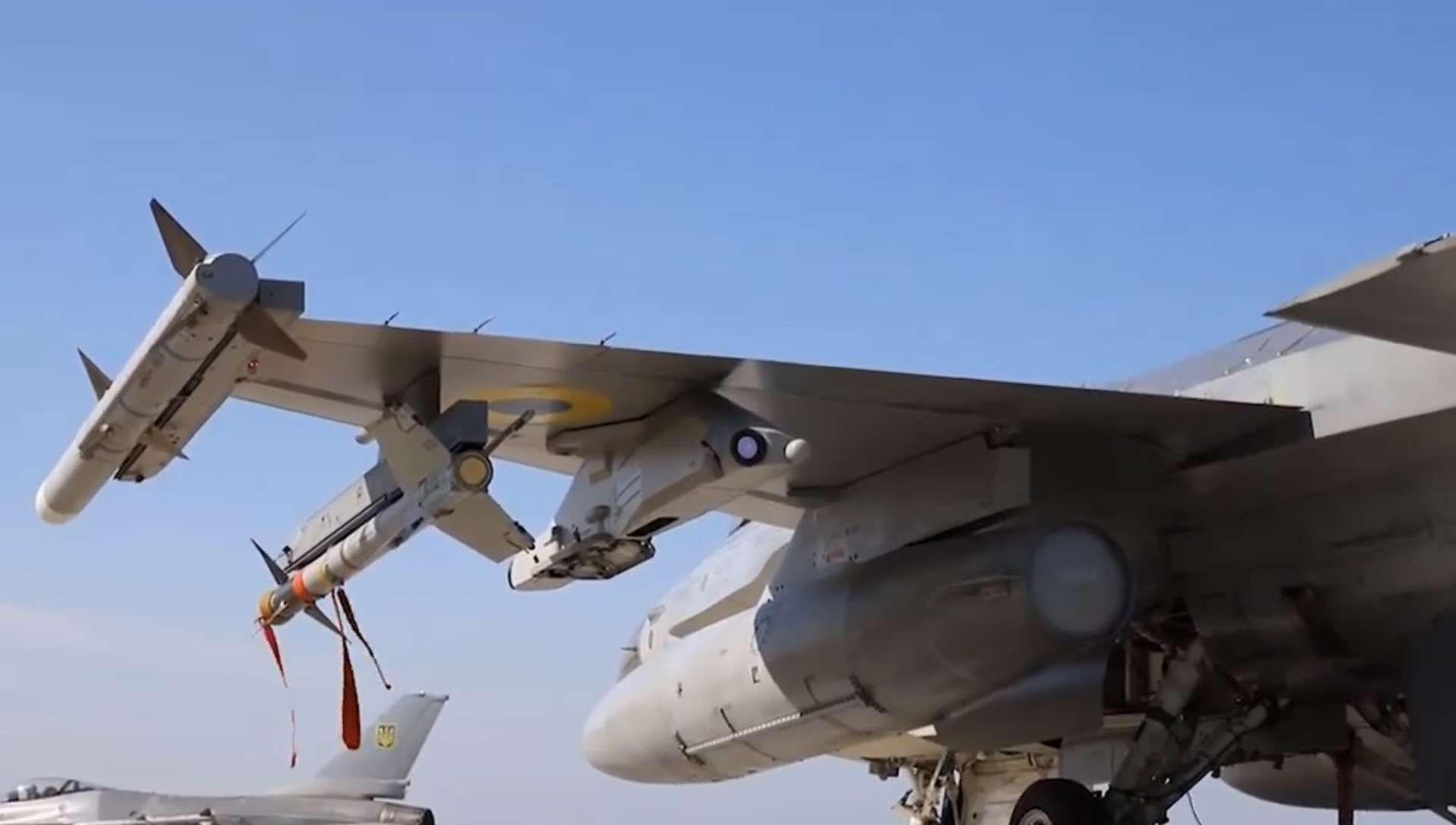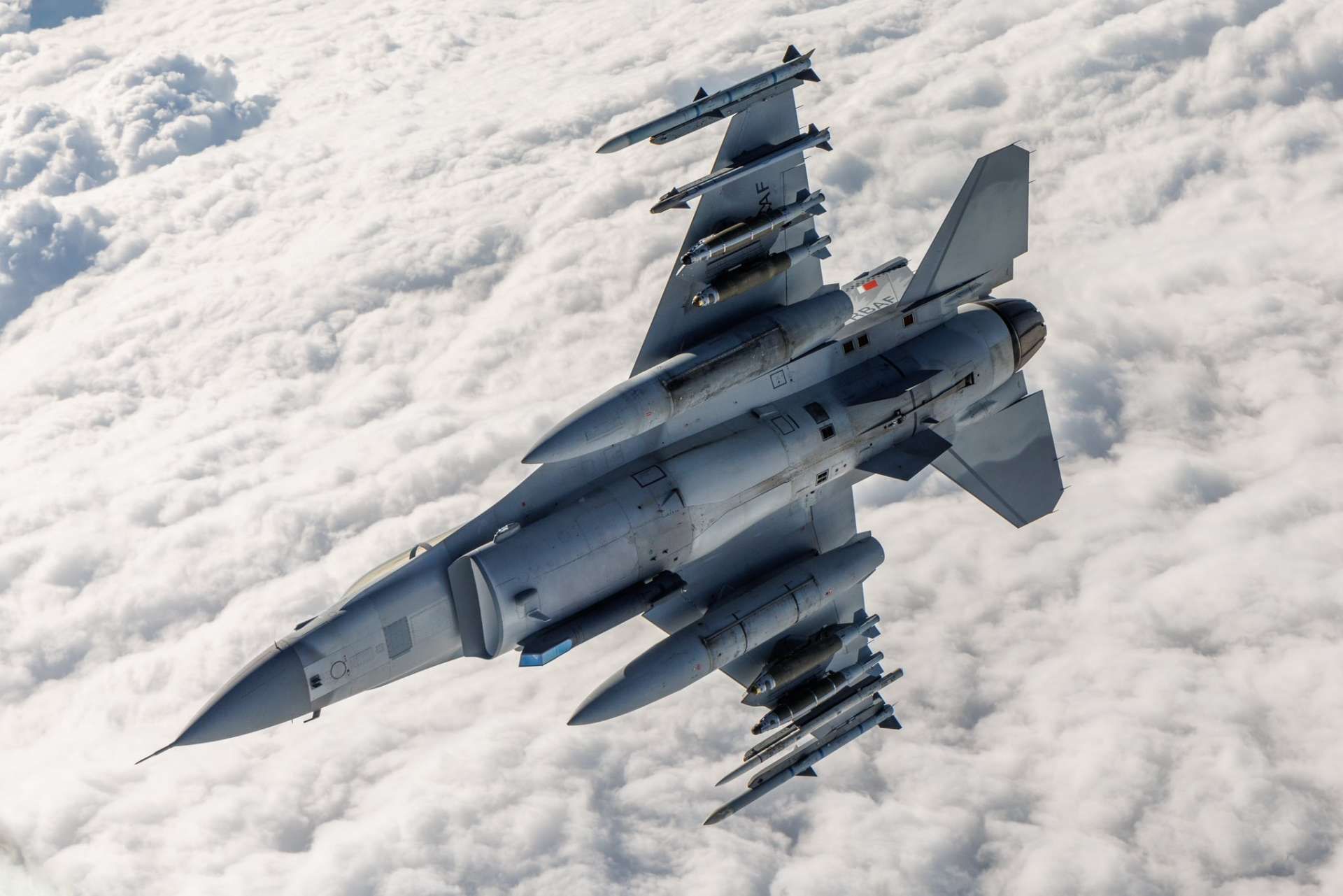Breaking News
Ukraine receives several F-16 Block 20 MLU fighter jets from Denmark.
On August 4, 2024, Ukrainian President Volodymyr Zelenskyy officially introduced some of Ukraine's newly arrived F-16 fighter jets, including two F-16 Block 20 MLU from Denmark with tail numbers 80-3596 and 80-3599. The event, coinciding with Ukraine's Air Forces Day, took place under tight security at an undisclosed location to protect the fighter jets from potential Russian attacks. These new fighter aircraft will provide relief to Ukraine's depleted fighter fleets of MiG-29s and Su-27s after more than two years of uninterrupted conflict.
Follow Army Recognition on Google News at this link

Ukrainian President Volodymyr Zelenskyy officially introduced some of Ukraine's newly arrived F-16 fighter jets, including two F-16 Block 20 MLU from Denmark with tail numbers 80-3596 and 80-3599. (Picture source: Ukrainian MoD)
“These jets are in our sky and today you see them,” said Zelenskyy, standing in front of two of the fighter jets, while two others flew overhead in close formation. The F-16 jets, featuring Ukraine’s trident insignia on their tails and covered in camouflage netting, served as the backdrop for the president’s address. Zelenskyy stated that these aircraft would support Ukraine's defense efforts.
Yehor Chernev, Deputy Chairman of the Parliamentary Committee on National Security, Defense, and Intelligence, and Head of the Permanent Delegation of Ukraine to the NATO Parliamentary Assembly, stated that the transfer of these aircraft is expected to motivate coalition countries to expedite their deliveries. Active efforts are ongoing to include more nations, such as the United States, in the coalition to provide additional aircraft and support.
"We have received a modern modification of the F-16 with the latest avionics, radars for targeting missiles, etc. We are also working on all possible options so that we can equip these aircraft with long-range weapons manufactured in Europe and the United States. The process is ongoing, and I hope that we will see such missiles in Ukraine," Chernev stated.
Chernev also emphasized the importance of training Ukrainian pilots and technical staff to maintain these aircraft. "Currently, there are not many bases in the world for this, so we are looking for opportunities in different countries to increase the number of our specialists," he concluded.

Russian President Vladimir Putin has warned that any Western air base hosting F-16s destined for Ukraine would be considered a legitimate target for Russian forces. This includes airfields in NATO countries such as Poland and Romania if they are used to stage F-16 operations against Russia. (Picture source: Army Recognition)
Defense Minister Troels Lund Poulsen of Denmark described the deployment of Danish F-16s as an important milestone in increasing Ukraine's combat aircraft capacity. Poulsen emphasized that this step is crucial for establishing a modern Ukrainian air force. He acknowledged the efforts of the Danish Armed Forces in training Ukrainian pilots and personnel, ensuring they are prepared to operate the F-16s despite the challenges posed by the ongoing conflict.
On July 31, the first batch of F-16 fighter jets from NATO allies arrived in Ukraine, including six aircraft confirmed from the Netherlands. By the end of 2024, Ukraine is expected to have 20 F-16s in operation, with the remaining aircraft, part of the 79 promised by a coalition led by Denmark and the Netherlands, arriving throughout 2025. With this official presentation, it is now known that these initial deliveries included two F-16s with tactical numbers 80-3596 and 80-3599, previously operated by the Royal Danish Air Force (RDAF).
The F-16s presented have specific features unique to Danish aircraft, such as the absence of a rear fairing housing the braking parachute and an interception light positioned on the port side, behind the radar radome, a modification common on Danish and Norwegian F-16s. The aircraft are also equipped with Terma's Pylon Integrated Dispensing System Plus (PIDS+) and Electronic Combat Integrated Pylon System Plus (ECIPS+) from Israel’s Elbit Systems, providing defensive capabilities through missile attack warning sensors and countermeasures, characteristic of Danish F-16AM/BM aircraft.

Regarding the armament, only air-to-air configured F-16s have been presented so far, equipped with American short-range AIM-9L/M Sidewinder missiles and medium-range AIM-120B AMRAAM missiles, along with external fuel tanks for extended range. (Picture source: Ukrainian MoD)
Regarding the armament, only air-to-air configured F-16s have been presented so far, equipped with American short-range AIM-9L/M Sidewinder missiles and medium-range AIM-120B AMRAAM missiles, along with external fuel tanks for extended range. This configuration suggests that the Ukrainian Air Force’s Fighting Falcons are currently performing air defense operations. Dutch Defense Minister Ruben Brekelmans previously confirmed that the F-16s delivered to Ukraine would initially not be used to support ground troops due to the pilots' lack of experience for such missions. Ukrainian military officials indicate that their initial use may be limited due to Moscow’s dense anti-aircraft network along the entire Ukrainian front.
Ukrainian F-16 pilots have also received Joint Helmet-Mounted Cueing System (JHMCS) helmet sights, which replace traditional windshield indicators, allowing pilots to aim and fire weapons based on their line of sight. This system enhances targeting accuracy, enabling pilots to shoot wherever they are looking, regardless of the direction of the helmet. In Russia, comparable helmet systems are not yet in widespread use, with domestic analogs still in testing phases.
The two F-16s now operated by the Ukrainian Air Force, with tactical numbers 80-3596 and 80-3599, have a notable history. Initially delivered to the Royal Danish Air Force (RDAF) as part of F-16A Block 15 in the early 1980s, these aircraft were upgraded to the Block 20 Mid-Life Update (MLU) configuration. With the tail number E-596, Aircraft 80-3596 served with RDAF Esk 727, Esk 723, Esk 726, and Esk 730, participating in operations such as Enduring Freedom and Odyssey Dawn, accruing significant flight hours over its service life. Similarly, aircraft 80-3599 (with the tail number E-599) served with RDAF Esk 730, Esk 723, and Esk 727, also participating in numerous NATO missions, including Odyssey Dawn and Air Policing Baltic States, reaching Denmark's 300,000 flight hours milestone in F-16 operations on February 24, 2015.

The E-599 reached Denmark's 300,000 flight hours milestone in F-16 operations on February 24, 2015. (Picture source: F-16.net/Mike Schoenmaker)
The F-16 Mid-Life Update (MLU) is a comprehensive upgrade program designed to extend the operational life and enhance the capabilities of the F-16 Fighting Falcon, a multirole fighter aircraft originally developed by General Dynamics (now Lockheed Martin). The MLU program includes significant improvements in avionics, radar systems, and overall performance, making the aircraft more effective in modern combat scenarios. The propulsion system typically includes a single Pratt & Whitney F100-PW-220/229 or General Electric F110-GE-100/129 afterburning turbofan engine, providing a maximum speed of over Mach 2.
Future capabilities for Ukrainian F-16s may include the integration of Sniper targeting pods paired with Advanced Precision Kill Weapon System (APKWS) rockets. This combination offers a cost-effective solution for defeating unmanned aerial systems (UAS) and provides precision strike capabilities. APKWS rounds cost approximately $30,000 each, with BAE Systems capable of producing over 20,000 rounds annually.
Additionally, the presentation included one F-16 in an unknown configuration, under camouflage nets, which could be used for training technical personnel or serve as a decoy. Recent reports indicate that Ukraine has received several mock-up F-16 aircraft from an undisclosed country to confuse Russian attacks, misdirecting enemy forces about the actual locations and numbers of operational F-16s. This strategic deception aims to protect such valuable assets and maintain operational security, and to help Ukraine maintain a significant number of operational decoys, essential given the recent Russian campaign targeting Ukrainian military airfields.

The F-16 is armed with an internal M61 Vulcan cannon and equipped with 11 hardpoints for various weapons, such as air-to-air missiles like the AIM-9 Sidewinder and AIM-120 AMRAAM, and air-to-ground munitions such as the GBU-12 Paveway II laser-guided bomb and the AGM-65 Maverick missile. (Picture source: US Air Force)
As reported on August 2, 2024, the first combat missions with these newly arrived F-16s have already been conducted, primarily in an air defense capacity. Despite the small number of planes, this marks a step in enhancing Ukraine's defense capabilities to counter Russian aerial threats. The exact number of operational pilots is small, with only six qualified so far according to some sources. Western aviation experts caution that the jets, while beneficial, are not a definitive solution to the conflict due to the persistent threat from Russian missile systems.
According to former Danish F-16 fighter pilot Søren Sørensen, the presence of F-16 aircraft in Ukraine is likely to have a psychological effect, making it harder for Russian forces to approach the front line. However, he also noted that the F-16’s impact would be limited by the skills of the Ukrainian pilots and the logistical challenges of maintaining and operating the aircraft in a war zone. Sørensen cautioned against expecting the F-16s to be a game-changer in the conflict, citing the limited number of aircraft and the extensive training required for effective deployment.

On July 31, 2024, the Ukrainian publication Dumskaya released what is believed to be the first photograph of an F-16 aircraft flying over Ukraine. Interestingly, the aircraft lacked identifying marks, including the flight number on its keel. (Picture source: Telegram/Dumskaya)


























